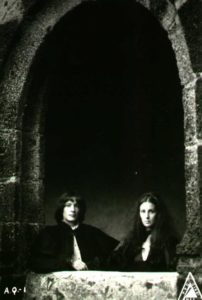 The first and most famous feature directed by Mexico’s Rafael Corkidi, who seems destined to be known primarily as the cinematographer of EL TOPO and THE HOLY MOUNTAIN—and after viewing the present film I feel that’s as it should be.
The first and most famous feature directed by Mexico’s Rafael Corkidi, who seems destined to be known primarily as the cinematographer of EL TOPO and THE HOLY MOUNTAIN—and after viewing the present film I feel that’s as it should be.
In its native Mexico, ANGELS AND CHERUBS (ANGELES Y QUERUBINES; 1972) was quite notorious for its extensive nudity and blasphemous overtones. The film is all-but forgotten today (and until recently was believed lost), as are Rafael Corkidi’s other self-directed efforts AUANDAR ANAPU (1975), DESEOS and PAFNUCIO SANTO (both 1977). There’s a reason for that!
This film begins with a surreal take on Adam and Eve featuring two naked young children frolicking in a beachfront Eden. The kids eventually happen upon what looks like a large egg that explodes when they try to play with it. A cackling man’s voice, apparently that of Big G himself, mocks the children’s endeavors.
From there the action switches to the interior of a dark castle where the freaky aristocrat Don Jacobo presides over a bizarre procession of monks and assorted mystics. The Don’s son Cristian falls in love with the alluring Angela, who comes from a middle class family living nearby. The Don strongly forbids the union before unexpectedly dropping dead, seemingly allowing Cristian and Angela to pursue their passions unabated.
Their bliss is short lived, however, as Angela promptly dies (I’m not sure why) and Cristian goes mad with desire for his beloved. Then the Don is unexpectedly brought back to life. It seems he’s a vampire, and so is Cristian…
Quite simply, this film is a bore. Like Rafael Corkidi’s other features, it’s highly reminiscent of the Alejandro Jodorowsky directed, Corkidi photographed EL TOPO in its overpowering air of mystical surrealism, yet lacks the invention and filmmaking savvy that made that film so affecting.
In ANGELS AND CHERUBS virtually every scene is allowed to drag on far longer than is necessary, regardless of how uneventful those scenes may be (watching a servant woman endlessly circle a dinner table, doling out soup over and over is about as interesting as it sounds), and there’s little in the way of a cogent narrative to hold it all together. In an apparent attempt at aping the craziness of the aforementioned EL TOPO, the film is crammed with surreal touches (telepathic puppets, an elaborate religious procession in the middle of a parched desert), but they feel gratuitous and fail to gel with the film overall.
Yet the photography, as we’ve come to expect from Corkidi, is stunning. Corkidi’s pictorial genius was a large part of what made Jodoroswky’s early films, as well as Juan Lopez Moctezuma’s MANSION OF MADNESS, such unforgettable experiences, and it gives ANGELS AND CHERUBS what little interest it contains. As visualized by Corkidi, the film’s endless deserts and opulently furnished interior sets are a wonder to behold, with all the hallucinatory brilliance the film otherwise fails to provide.
Vital Statistics
ANGELS AND CHERUBS (ANGELES Y QUERUBINES)
Cine Producciones
Director/Screenwriter/Cinematographer: Rafael Corkidi
Producer: Roberto Viskin
Screenplay: Carlos Illescas
Editing: Federico Landeros
Cast: Roberto Canedo, Jorge Humberto Robles, Helena Rojo, Ana Luis Peluffo, Lea Corkidi, Oablo Corkidi, Pablo Corkidi, Cecilia Pezet, David Silva, Coalito, Max Liszt
